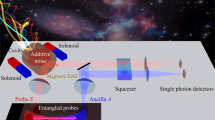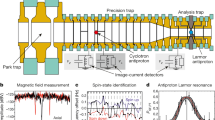Abstract
The manipulation of quantum states of light1 holds the potential to enhance searches for fundamental physics. Only recently has the maturation of quantum squeezing technology coincided with the emergence of fundamental physics searches that are limited by quantum uncertainty2,3. In particular, the quantum chromodynamics axion provides a possible solution to two of the greatest outstanding problems in fundamental physics: the strong-CP (charge–parity) problem of quantum chromodynamics4 and the unknown nature of dark matter5,6,7. In dark matter axion searches, quantum uncertainty manifests as a fundamental noise source, limiting the measurement of the quadrature observables used for detection. Few dark matter searches have approached this limit3,8, and until now none has exceeded it. Here we use vacuum squeezing to circumvent the quantum limit in a search for dark matter. By preparing a microwave-frequency electromagnetic field in a squeezed state and near-noiselessly reading out only the squeezed quadrature9, we double the search rate for axions over a mass range favoured by some recent theoretical projections10,11. We find no evidence of dark matter within the axion rest energy windows of 16.96–17.12 and 17.14–17.28 microelectronvolts. Breaking through the quantum limit invites an era of fundamental physics searches in which noise reduction techniques yield unbounded benefit compared with the diminishing returns of approaching the quantum limit.
This is a preview of subscription content, access via your institution
Access options
Access Nature and 54 other Nature Portfolio journals
Get Nature+, our best-value online-access subscription
$29.99 / 30 days
cancel any time
Subscribe to this journal
Receive 51 print issues and online access
$199.00 per year
only $3.90 per issue
Buy this article
- Purchase on Springer Link
- Instant access to full article PDF
Prices may be subject to local taxes which are calculated during checkout



Similar content being viewed by others
Data availability
The data central to the results of this manuscript are available from the corresponding author upon reasonable request.
Code availability
The custom codes used to produce the results presented in this manuscript are available from the corresponding author upon reasonable request.
References
Slusher, R. E., Hollberg, L. W., Yurke, B., Mertz, J. C. & Valley, J. F. Observation of squeezed states generated by four-wave mixing in an optical cavity. Phys. Rev. Lett. 55, 2409–2412 (1985).
Tse, M. et al. Quantum-enhanced advanced LIGO detectors in the era of gravitational-wave astronomy. Phys. Rev. Lett. 123, 231107 (2019).
Brubaker, B. M. et al. First results from a microwave cavity axion search at 24 μeV. Phys. Rev. Lett. 118, 061302 (2017).
Peccei, R. D. & Quinn, H. R. CP conservation in the presence of pseudoparticles. Phys. Rev. Lett. 38, 1440–1443 (1977).
Preskill, J., Wise, M. B. & Wilczek, F. Cosmology of the invisible axion. Phys. Lett. B 120, 127–132 (1983).
Dine, M. & Fischler, W. The not-so-harmless axion. Phys. Lett. B 120, 137–141 (1983).
Abbott, L. & Sikivie, P. A cosmological bound on the invisible axion. Phys. Lett. B 120, 133–136 (1983).
Braine, T. et al. Extended search for the invisible axion with the axion dark matter experiment. Phys. Rev. Lett. 124, 101303 (2020).
Malnou, M. et al. Squeezed vacuum used to accelerate the search for a weak classical signal. Phys. Rev. X 9, 021023 (2019).
Buschmann, M., Foster, J. W. & Safdi, B. R. Early-universe simulations of the cosmological axion. Phys. Rev. Lett. 124, 161103 (2020).
Klaer, V. B. & Moore, G. D. The dark-matter axion mass. J. Cosmol. Astropart. Phys. 2017, 049 (2017).
Ade, P. A. et al. Planck 2015 results – XIII. Cosmological parameters. Astron. Astrophys. 594, A13 (2016).
Bertone, G. & Tait, T. M. P. A new era in the search for dark matter. Nature 562, 51–56 (2018).
Ouellet, J. L. et al. First results from ABRACADABRA-10 cm: a search for sub-μev axion dark matter. Phys. Rev. Lett. 122, 121802 (2019).
Majorovits, B. et al. Madmax: a new road to axion dark matter detection. J. Phys. Conf. Ser. 1342, 012098 (2020).
Arvanitaki, A. & Geraci, A. A. Resonantly detecting axion-mediated forces with nuclear magnetic resonance. Phys. Rev. Lett. 113, 161801 (2014).
Garcon, A. et al. The cosmic axion spin precession ex-periment (CASPEr): a dark-matter search with nuclear magnetic resonance. Quantum Sci. Technol 3, 014008 (2018).
Zhong, L. et al. Results from phase 1 of the HAYSTAC microwave cavity axion experiment. Phys. Rev. D 97, 092001 (2018).
Lee, S., Ahn, S., Choi, J., Ko, B. R. & Semertzidis, Y. K. Axion dark matter search around 6.7 μeV. Phys. Rev. Lett. 124, 101802 (2020).
Sikivie, P. Experimental tests of the “invisible” axion. Phys. Rev. Lett. 51, 1415–1417 (1983).
Rapidis, N. M., Lewis, S. M. & van Bibber, K. Characterization of the HAYSTAC axion dark matter search cavity using microwave measurement and simulation techniques. Rev. Sci. Instrum. 90, 024706 (2019).
Caves, C. M., Thorne, K. S., Drever, R. W. P., Sandberg, V. D. & Zimmermann, M. On the measurement of a weak classical force coupled to a quantum-mechanical oscillator. I. Issues of principle. Rev. Mod. Phys. 52, 341–392 (1980).
Palken, D. A. et al. Improved analysis framework for axion dark matter searches. Phys. Rev. D 101, 123011 (2020).
Kim, J. E. Weak-interaction singlet and strong CP invariance. Phys. Rev. Lett. 43, 103–107 (1979).
Shifman, M. A., Vainshtein, A. I. & Zakharov, V. I. Can confinement ensure natural CP invariance of strong in-teractions? Nucl. Phys. B 166, 493–506 (1980).
Gorghetto, M., Hardy, E. & Villadoro, G. Axions from strings: the attractive solution. J. High Energy Phys. 2018, 151 (2018).
Yamamoto, T. et al. Flux-driven Josephson parametric amplifier. Appl. Phys. Lett. 93, 042510 (2008).
Primakoff, H. Photo-production of neutral mesons in nuclear electric fields and the mean life of the neutral meson. Phys. Rev. 81, 899 (1951).
Al Kenany, S. et al. Design and operational experience of a microwave cavity axion detector for the 20 – 100 μeV range. Nucl. Instrum. Methods Phys. Res. A 854, 11–24 (2017).
Caves, C. M. Quantum limits on noise in linear ampli-fiers. Phys. Rev. D 26, 1817–1839 (1982).
Malnou, M., Palken, D. A., Vale, L. R., Hilton, G. C. & Lehnert, K. W. Optimal operation of a Josephson parametric amplifier for vacuum squeezing. Phys. Rev. Appl. 9, 044023 (2018).
Brubaker, B. M., Zhong, L., Lamoreaux, S. K., Lehnert, K. W. & van Bibber, K. A. HAYSTAC axion search analysis procedure. Phys. Rev. D 96, 123008 (2017).
Burkhart, L. D. et al. Error-detected state transfer and entanglement in a superconducting quantum network. Preprint at https://arxiv.org/abs/2004.06168 (2020).
Braunstein, S. L. & van Loock, P. Quantum information with continuous variables. Rev. Mod. Phys. 77, 513–577 (2005).
Tanabashi, M. et al. Review of particle physics. Phys. Rev. D 98, 030001 (2018).
Di Luzio, L., Giannotti, M., Nardi, E. & Visinelli, L. The landscape of QCD axion models. Phys. Rep. 870, 1–117 (2020).
Dine, M., Fischler, W. & Srednicki, M. A simple solution to the strong CP problem with a harmless axion. Phys. Lett. B 104, 199–202 (1981).
Zhitnitsky, A. R. On possible suppression of the axion hadron interactions. Sov. J. Nucl. Phys. 31, 260 (1980).
Palken, D. A. Enhancing the Scan Rate for Axion Dark Matter: Quantum Noise Evasion and Maximally Informative Analysis. PhD thesis, Univ. of Colorado Boulder (2020).
Acknowledgements
We acknowledge support from the National Science Foundation under grant numbers PHY-1701396, PHY-1607223, PHY-1734006, PHY-1914199 and PHY-2011357 and the Heising-Simons Foundation under grants 2016-044 and 2016-044. We thank K. Thatcher and C. Schwadron for work on the design and fabrication of the SSR mechanical components, F. Vietmeyer for work on the room-temperature electronics and S. Burrows for graphical design work. We thank V. Bernardo and the J. W. Gibbs Professional Shop as well as C. Miller and D. Johnson for assistance with fabricating the system’s mechanical components. We thank M. Buehler of Low-T Solutions for cryogenics advice. Finally, we thank the Wright laboratory for housing the experiment and providing computing and facilities support.
Author information
Authors and Affiliations
Contributions
K.M.B. ran the experiment with support from D.A.P., D.H.S., S.G., H.W., S.B.C., R.H.M. and S.K.L. Data were analysed by D.A.P. and K.M.B. with D.H.S, E.C.v.A. and H.W. contributing. K.M.B., M.M., D.A.P., S.M.L., N.M.R., A.D., D.H.S., E.C.v.A., R.H.M and S.K.L. designed and assembled the experiment. D.A.P., M.M., B.M.B. and K.W.L. developed the squeezing concept. K.M.B. developed and implemented squeezing and other operational procedures with support from D.A.P., D.H.S, E.C.v.A. and H.W. The JPAs were designed by M.M., D.A.P. and K.W.L. and fabricated by L.R.V. and G.C.H. The cavity was designed and tested by N.M.R., S.M.L., S.A.K., H.J., A.F.L., M.S., A.D., I.U. and K.v.B. All authors, led by K.M.B. and D.A.P., contributed to the manuscript with figures created by S.G. and H.W.
Corresponding author
Ethics declarations
Competing interests
The authors declare no competing interests.
Additional information
Peer review information Nature thanks Igor Irastorza, David Marsh and the other, anonymous, reviewer(s) for their contribution to the peer review of this work. Peer reviewer reports are available.
Publisher’s note Springer Nature remains neutral with regard to jurisdictional claims in published maps and institutional affiliations.
Extended data figures and tables
Extended Data Fig. 1 Simplified HAYSTAC experimental diagram.
A single signal generator provides the local oscillator (LO) tone, as well as the tones for pumping both JPAs (SQ, AMP). Each JPA has two ports: one for the input of pump tones and one for input/output signals. The LO is set at half the pump frequencies via a frequency divider, and the relative phase and amplitude of the pump tones are set using a variable phase shifter and attenuator on the SQ pump line. Switches in the SQ and AMP pump lines (not shown) are used to toggle the JPAs on and off. Microwave circulators route signals nonreciprocally in order to realize the time sequence of operations illustrated in Fig. 1. Circulators with a 50-Ω termination on one port act as isolators, shielding upstream circuit elements from unwanted noise coming from further down the measurement chain. During data acquisition and calibration measurements, signal and noise emitted from and reflected off the cavity are amplified by a HEMT amplifier at 4 K, fed into the RF port of an IQ mixer and mixed down to an intermediate frequency, digitized (ADC) and read into the computer (PC) where the power spectral density is calculated. The cavity’s Lorentzian profile is monitored with reflection and transmission measurements taken using a VNA, for which a portion of the output is split off before the mixer. A switch that toggles between hot (333 mK) and cold (61 mK) 50-Ω loads is used for the calibration measurements described in the text.
Supplementary information
Rights and permissions
About this article
Cite this article
Backes, K.M., Palken, D.A., Kenany, S.A. et al. A quantum enhanced search for dark matter axions. Nature 590, 238–242 (2021). https://doi.org/10.1038/s41586-021-03226-7
Received:
Accepted:
Published:
Issue Date:
DOI: https://doi.org/10.1038/s41586-021-03226-7
This article is cited by
-
Long-baseline quantum sensor network as dark matter haloscope
Nature Communications (2024)
-
Quantum sensing for particle physics
Nature Reviews Physics (2024)
-
Experimental realization of a 12,000-finesse laser cavity based on a low-noise microstructured mirror
Communications Physics (2023)
-
Broadband squeezed microwaves and amplification with a Josephson travelling-wave parametric amplifier
Nature Physics (2023)
-
Realizing spin squeezing with Rydberg interactions in an optical clock
Nature (2023)
Comments
By submitting a comment you agree to abide by our Terms and Community Guidelines. If you find something abusive or that does not comply with our terms or guidelines please flag it as inappropriate.



